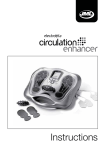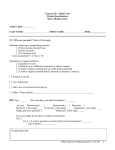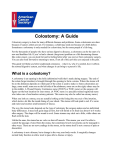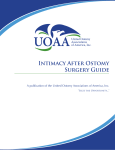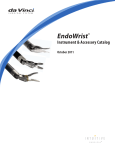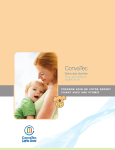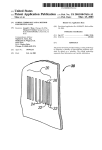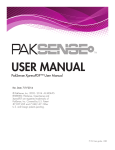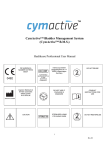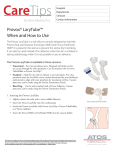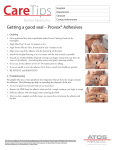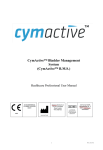Download New Patient Guide: Urostomy - United Ostomy Associations of
Transcript
New Patient Guide Urostomy Find A Local Support Group www.ostomy.org or Call 800-826-0826 A publication of Urostomy New Patient Guide This publication is funded by the nonprofit United Ostomy Associations of America and advertising. It is distributed free of charge to new ostomy patients, care givers and medical professionals. Content has been reprinted from The Phoenix magazine, the official publication of the UOAA. Subscriptions are a main source of funding for UOAA. To subscribe, call 800-750-9311, www.phoenixuoaa.org or return a subscription card in this publication with payment. You can also send $29.95 for a one-year subscription to the address below. Publisher, Editor, Advertising Ian Settlemire [email protected] 800-750-9311 FAX 678-960-1231 P.O.Box 3605 Mission Viejo, CA 92690 Medical Advisors David Beck, MD Janice Rafferty, MD Marlene Muchoney, RN, CWOCN ©The Phoenix Magazine 2012. No part of this publication may be reproduced without the prior written permission of the publisher. Printed in the U.S.A. Opinions expressed by authors are their own and not necessarily those of the United Ostomy Associations of America Inc., the publisher, the editorial consultants or advisers. The publisher makes no representation concerning the accuracy or truth of any matter or statement in any advertisement contained herein and disclaims all liability relating thereto. Advertising rates and requirements sent on request: [email protected] or 800-750-9311. Urostomy New Patient Guide Dear New Ostomy Patient, Welcome to your New Patient Guide, made possible by the United Ostomy Associations of America, UOAA’s official publication, The Phoenix magazine, and over 300 affiliated support groups of the UOAA. We at UOAA believe that it is very important for both you and your support team to have as much information about your ostomy as possible. Undoubtedly, you have heard many stories about people with an ostomy or related procedure. Very often, we find that these stories are based on myth, ignorance, and “old wives’ tales”, rather on truth and real life experiences. We are here to dispel these tales and help all ostomates move beyond the stigma which is sometimes associated with having an ostomy. In this guide, you will find answers by medical professionals to many of your basic questions, information and hints about living with your ostomy, and hear from an ostomy patient who has returned to a full and productive life after surgery – one of the 700,000+ people in the U.S. with an ostomy. UOAA is a volunteer-managed non-profit organization whose vision is for the creation of a society where people with bowel and urinary diversions are universally accepted socially, in the work place, medically and psychologically. UOAA’s comprehensive website, www.ostomy.org, includes ostomy information on UOAA’s various programs and activities, support group locations, and discussion boards; all of which will enable you to connect, ask questions, and get advice from other ostomates – ostomates just like you! UOAA staffs a toll-free help line at 1-800-826-0826. Find out about making a donation, a support group in your area, our certified peer-visitor program or to talk to an ostomy nurse. If you experience some form of discrimination as a result of your surgery, you can call our help line and they will put you in touch with a specialist. Membership in UOAA is through one of our affiliated support groups, or AGSs. Our local ASGs have support and educational meetings where you can get answers to the questions that so many ostomates have, and it is a place where fellow members can share their experiences. You will find that either upon attending a meeting, posting on one of our discussion boards or by joining a virtual group that you will be greeted warmly, and will be treated like a member of our extended family. Be Well, UOAA Management Board of Directors P.S. To get more answers about living a full, secure and successful life with an ostomy, go to www.phoenixuoaa.org or call 800-750-9311 and subscribe to America’s leading ostomy publication. Subscriptions to The Phoenix account for a major source of revenue for UOAA, so please subscribe today! The Phoenix 3 Ask Dr. Basler Phantom Bladder, Nutrition, Life Expectancy More Convenience I had urostomy surgery three months ago. I don’t like to empty my pouch more than I have to. Will I have any problems if I drink less water so I don’t have to empty the pouch so often? Joseph W Basler, Ph.D., M.D., is the Thomas P. Ball Professor of Urology and Chief Section of Urology at South Texas VAHCS, Program Director in Urology at the The University of Texas Health Science Center at San Antonio, Texas. Dr. Basler also currently serves as president of Texas Urologic Society, representing over 400 member urologists. Send questions to [email protected] or P.O. Box 3605 Mission Viejo, CA 92690 As you long as you don’t restrict fluid too much. You don’t want to get dehydrated and have infections or stones. You can also consider hooking the spigot at the bottom of the urostomy pouch to a leg bag…it may give you more capacity. Speak with your ostomy nurse for further suggestions. Decreased Output My urostomy output sometimes slows down and I will have very little output for a day at a time. Is this normal? The Phoenix Diet Adjustment I have an ileal conduit and wear a pouch to collect the urine. Will I need to change my diet now that some of my small intestine is now being used for urine instead of absorbing nutrients as it used to? Not entirely ‘normal’ and may indicate some abnormal dilation of the conduit or internal blockage. Sometimes, this is seen if the conduit is kinked due to body position or habitus. Ask your urologist if he sees any blockage of the upper tracts or the conduit below the skin. Usually, only a short section of ileum is used, so absorption of nutrients proceeds without a problem. If the segment was from the distal ileum, sometimes B-12 deficiency can result. This is treated with supplements. If too long a segment was removed for the conduit, acidosis can occur. Your doctor can advise you regarding tests that can help identify these problems. Phantom Bladder Long-term Urostomy I had my bladder removed about six months ago. Occasionally, I have the sensation of a full bladder and that I need to go to the bathroom, but I know that’s impossible since I don’t have a bladder any more. Is this normal? Will I have these sensations for the rest of my life? Will having a urostomy decrease my life expectancy? Can the cancer come back even though I had my bladder removed? Depends… You didn’t mention whether you were diverted with an ileal conduit or had a bladder replacement operation. Generally, the sensation of the need to void can be mediated by fluid that leaks into an area called the ‘posterior urethra’. This is 4 usually surrounded by the prostate. If part of this area was left behind and attached to a new bladder, the sensation of urgency may still be present. If some of this area was left at the end of a urethral stump (as would be the case with an ileal conduit) any secretion from periurethral glands or fluid from the pelvis may simulate this sensation. Generally, if you take care to avoid infection and monitor for obstruction of the urinary system, the life expectancy should not change much. However, whether the cancer has been completely removed is another question. You should discuss the final pathology report from your surgery with your urologist. He can let you know whether he thinks he got it all and what the likelihood of cancer recurrence is. Urostomy New Patient Guide Pay Less for Ostomy Supplies MUCH LESS! Up to 50% less depending on where ostomy supplies are purchased. 1-800-453-8898 www.parthenoninc.com I www.devrom.com Call us for an estimate the next time you buy ostomy supplies. We beat any advertised price by 5% Family owned and operated since 1961 3311 West 2400 South Salt Lake City, Utah 84119 [email protected] Follow Us On Facebook and Twitter Ask Nurse Muchoney Proper Fit, Showering, Pouch Patching Marlene Muchoney has been an ostomy nurse for over 28 years. She is nationally board certified in wound, ostomy, and continence nursing. She has been awarded the Quality of Life Award by the American Cancer Society, was a runnerup for the Nightingale of Pennsylvania State Award and received the Cameo of Caring Award for excellence in nursing from the University of Pittsburgh School of Nursing. Send questions to [email protected] or P.O. Box 3605 Mission Viejo, CA 92690 6 The Phoenix Fitting Flanges Over Protection What determines the flange size a person should use? I have been using the same size they gave me in the hospital and wonder if I can use something smaller that will not be so noticeable. Do I need to wear gloves when caring for my urostomy? As stomal sizes change, flanges can also change. Most companies provide guidelines advising proper flange size based on the stomal measurement. You need an adequate barrier on the flange, but remember that too small can cause stomal injury. If you are unsure, contact the company who manufactures your flanges for advice or contact your local ostomy nurse. Larger flanges can be used for small stomas as long as the stomal pattern is correct. Some people feel more secure with a little extra adhesive backing on the flange. In general however, wearing the smallest appropriate size flange is most desirable. Proper Disposal How should I properly dispose of used ostomy equipment? Do not flush any ostomy equipment unless it is specifically designed for that. I do not have any personal experience with “flushable” pouches, but would love to hear from someone who has used them. The correct way (and safe for disposal) is to empty pouches, put them into one or two Zip-lock® style plastic bags and put them into your regular garbage. You can also put them into an opaque plastic bag or line clear ones with paper towels prior to disposal. Pouching systems intended to be reused for longer periods of time should be cleansed as per the manufacturer’s instructions. Washcloths and towels should be laundered in the usual fashion. No. You do not need to wear gloves, but you should wash your hands before and after care. Pouch Patching If I notice leakage under the outside edge of my wafer, is it okay to add paste or more tape to keep it in place? It is not advisable to “patch” wafers that are beginning to leak or undermine. The only exception might be to buy a little time until the wafer can be fully changed. Patching the edges does not stop the leakage. It only traps the drainage under the wafer possibly resulting in irritated or damaged peristomal skin. Convexity What exactly is a convex wafer? A convex wafer has a back surface that curves in toward the abdomen; it appears slightly cup-shaped vs. flat. They are used to improve wearing time, reduce leakage problems and prevent irritated peristomal skin and for retracted stomas, a soft abdomen, stomas in creases or folds or even a history of frequent leakage in some cases. Occasionally, a support belt is added to assist with the convexity. Prescription for Supplies? Do I need a prescription every time I want to try a new ostomy product? Yes, it is my experience that you need a prescription for new products to utilize insurance coverage. I recommend continued on page 34 Urostomy New Patient Guide (SFBU0TUPNZ"DDFTTPSJFT GGSPN4BGFOTJNQMFUP1SPNPUF SPN4B .BJOUBJO)FBMUIZ4LJO .B 4LJO#BSSJFS 3JOHT (ELPS0REVENT,EAKAGEAND3KIN )RRITATION!ROUNDTHE3TOMA 0ROVIDESA"ETTER&IT AND,ONGER7EAR4IME %ASYTO3QUEEZE4UBE0ASTEIS %ASYTO2EMOVE&ROM4UBE */5&(3*5: 4LJO#BSSJFS3JOHT i3JOH*UFN4/4 3JOH*UFN4/4 1BDLBHJOH3JOHT#PY *UFN4/4 1BDLBHJOHP[5VCF /&8 $POGPSNJOH "EIFTJWF4FBMT /&8 *UFN4/4ʳ1BDLBHJOHP[5SBWFM1BDL *UFN4/4ʳ1BDLBHJOHP[#PUUMF 9USB8JEF4LJO#BSSJFS"SDT i3JOH*UFN4/46 1BDLBHJOH3JOHT#PY #ANBEPLACEDDIRECTLYONTHESKINAROUNDTHESTOMATO CREATEAPLATFORMFORTHEPOUCHSYSTEMTOADHERETO 0ROTECTSTHESKINFROMTRAUMACAUSEDBYREPETITIVE REMOVALOFTAPESANDADHESIVES #ANBEPLACEDAROUNDTHETOPEDGESOFTHEWAFERTO SECUREITFROMLIFTINGUPCREASINGORLOOSENING *UFN4/4 1BDLBHJOH4USJQT5SBZ TBGFOTJNQMF www.SnSmedicalwipes.com TM $BMM'PS'SFF4BNQMFT -JLF TBGFOTJNQMF PO'BDFCPPL Safen’simple LLC Clarkston, MI 48348 Phone (248) 214-4877 Fax (248) 698-3454 Safen’simple is an innovator that develops and markets high-quality, cost-effective ostomy accessories. The Ostomy Book The improved and updated edition of an ostomy classic By Cliff Kalibjian The long-awaited third edition of The Ostomy Book is finally here. Prompted by a review of the second edition (published in 1992) last year in The Phoenix magazine entitled, “A Classic In Need of Revision,” Kerry Ann McGinn rose to the challenge and delivered within a year’s time. As in the second edition, McGinn has preserved the personal stories, including those of her mother, Barbara Dorr Mullen, who passed away peacefully between the time of the first and second edition. What’s new in this book is information on the latest treatments, surgical procedures, ostomy equipment and statistics. Kudos to McGinn for blending her updates so seamlessly with her mother’s original stories. For example, before Mullen describes her three roommates in her hospital room, McGinn slips in a line about how most patients today have either private rooms or just one roommate, thus eliminating potential fears about staying in the hospital that one might develop if they assumed multiple roommates were still the norm. The Ostomy Book is filled with wonderful personal stories, mainly those of Mullen, but of others as well. In the first several chapters, Mullen describes her cancer diagnosis, surgery and hospitalization in detail. In addition to simply sharing her experiences, Mullen shares her feelings, to which most ostomates will be able to relate. When trying to make sense of it all, Mullen asks, “Why did this happen to me? I always ate my spinach.” Mullen shares her wisdom on the grieving process, which most people with an ostomy experience when losing even the most diseased organ. She explains, very insightfully, how we really cannot see the “bright side” until we’ve allowed ourselves to feel all of our negative emotions, such as sorrow, anger, loss and fear. Throughout the book, Mullen also touches on an extremely important topic: the strength and ingenuity of the human spirit. For instance, in places where people are 8 The Phoenix either unaware of or without modern ostomy supplies, she shares how people have adapted to their ostomies in ways that many would consider the most unusual in order to fully live their lives: taping a tuna fish can, waterproofed cigar box or old-fashioned rubber glove to their belly. She also relates a story of a woman who was told she had only six months to live, but then decided to simply get busy living in the present. Six years later, she was still alive, but her surgeon was not. And sixteen years later, she was still alive and well and celebrating her 92nd birthday. Readers of The Ostomy Book will not be at a loss for up-to-date, factual information regarding various ostomy topics. The book includes chapters for people undergoing colostomies, ileostomies, urostomies as well as any continent and temporary procedure associated with them. Excellent illustrations are included as well to help readers fully understand the various surgeries. The latest on pouches, skin care and check-ups/tests following surgery is included as well. What’s nice about the book is that you can read it all the way through from start to finish, or you can just as easily read an individual chapter on its own if you are looking for specific information on a topic, such as sex, work, travel, sports, pregnancy or children and teenagers. A glossary and resources section are included, as well as a patient’s bill of rights in one of the early chapters. The Ostomy Book is so comprehensive that a reader, after finishing the book, would be hard pressed to think of a relevant topic it does not cover. It’s simply an excellent resource that every person with an ostomy, along with their closest friends and family members, should read. Ostomy nurses and physicians who perform ostomy surgeries would be wise to recommend it to their patients as well. On behalf of people with ostomies around the world, special thanks to Kerry Ann McGinn for taking the time to update the book. Hopefully, she won’t wait so long when it comes time for the fourth edition! Urostomy New Patient Guide Urostomy Surgery and Care What’s right for you By Joy Boarini, MSN, WOC Nurse Clinical Education Manager, Hollister Incorporated If you are about to have — or have recently had — ostomy surgery, it is important to remember that you are not alone. Every year, thousands of people undergo ostomy surgery and it is natural to have questions and concerns. There are three basic types of ostomies – a colostomy, an ileostomy and a urostomy. Although there are many similarities between these ostomies, it is what makes them different that is crucial to proper care and to avoiding possible complications. It is important for you to know what kind of ostomy you have. This article will focus on the unique aspects of a urostomy. Overview A urostomy is an ostomy, or surgical opening, created to drain urine. A urostomy may also be called an ileal conduit and is one type of urinary diversion. It allows urine to flow out of the body after the bladder has been removed or bypassed. Because there is no sphincter muscle, there is no control over when to urinate. Instead, an external pouching system collects urine. One specific and common type of surgical construction is called an ileal conduit (Figure 1). When you have an ileal conduit, your stoma drains not only urine, but also various amounts of mucus. Reasons for the creation of a urostomy may include bladder cancer, spinal cord injury, bladder malfunction and spina bifida. It is estimated that approximately 38,0001 urostomy surgeries are done each year in the United States. If you have not yet had your surgery, determining where the stoma (a surgically created opening) will be placed on your abdomen is a very important part of the preoperative preparation. Quite often, an ileal conduit stoma is located on the abdomen just below your waist and to the right of your navel (belly button). Before 10 The Phoenix surgery, your WOC Nurse and your surgeon can help determine the best location for your stoma. Ideally, the stoma should be placed on a smooth skin surface and should be located where you can see it easily and take care of it yourself. After Surgery After surgery, you will have a pouch which will collect urine. Initially, the urine may be tinged with blood, this is normal. As time goes on, it should lighten up and the color should be very similar to the color your urine used to be. After surgery, there may be stents or small tubes in the stoma. These are temporary (days to weeks) and will be removed by your surgeon or wound, ostomy and continence nurse or WOC nurse. In the hospital, the staff will use a pouching system that allows them to best manage and monitor your care following surgery. Here are some common pouching system features and practices that follow urostomy surgery: • Your pouch will be transparent or clear so that your doctors and nurses can observe your urine. • Hospitals will generally use a product that has a cut-to-fit or shapeto-fit skin barrier. This allows the staff to customize the opening so that your skin is protected from contact with the urine. • The pouching system used may be a one-piece or a two-piece — at this early point in your recovery, it does not really matter. What is important is that you get a secure seal and time to recover from your operation. • During your hospital stay, your pouch may be connected to a urinary drainage bag. This bag has tubing and a larger capacity to collect your urine. It makes it possible for the nursing staff to accurately measure your urine output and empty your pouch without disturbing you as often. • A urostomy pouch typically has a spout or tap at the bottom. This is unique to a pouch which needs to drain urine. The spout makes it easier to empty urine and is different from drainable pouches used for colostomies and ileostomies. • A urostomy pouch is also unique from other ostomy products in that it typically has anti-reflux or Urostomy New Patient Guide no-flow back valves. These are not easy to see, but are an important built-in feature of most urostomy pouches. This helps prevent the urine from flowing back up onto your stoma and skin barrier when you lie down or recline When You Go Home After discharge from the hospital, you will still need time for recovery. In addition to your ostomy, you will have incision lines and possibly a drain and/or stents. You will need to follow your physician’s orders as it relates to activity, medications, diet and follow-up. Since your hospital stay may be short, it is not uncommon to have a home care nurse visit you in your home to assist with learning to care for your stoma. These nurses to consider: may not have the same level of • The skin barrier of your Ostomy Suppliers expertise that your WOC nurse pouching system is very • Ostomy products are usually not available has when it comes to ostomy important. It is the sticky part in drug stores or retail pharmacies care. However, they can assist that protects your skin and you and your family as you learn helps to hold your pouch on • You want to be sure you evaluate the to become more comfortable your body. If you are not using services provided by your supplier. They and proficient in your skills and an extended wear skin barrier, can vary. For example, some suppliers self-care. you may wish to ask about this. will cut your skin barrier to your size for a minimal fee. If this is important to you, In addition, there are also Extended wear skin barriers are it is something you should ask about. services provided by ostomy specifically designed to hold product manufacturers that up well to the challenges of • Be sure that the supplier you are working can help with your transition fluid (urine) output. They tend with not only provides you with your from hospital to home. They to work best for urostomies. products but is also in-network with your can assist you by answering • Your stoma size may specific insurance plan. This will help to product and lifestyle-related change over the first six to minimize your out-of-pocket expenses. questions, providing basic eight weeks after surgery. For • Many suppliers will ship a three-month educational materials, helping that reason, you may want to supply of products at one time. you find a pouching system continue to use a cut-to-fit skin • If a prescription is needed to bill your that works for you, and barrier. However, it is important insurance, your supplier should assist assisting you with finding an into continue to change the size with obtaining that for you. network supplier who will mail you cut or shape your skin your supplies to you. All of barrier to, so that all your skin • Not all pouching systems are the same. these can be valuable services is covered and protected. Once If a substitution is recommended, be in addition to what you receive your stoma size stops changing, sure you understand why and that it from your health care team. you may want to consider a works for you. As time goes by, you will pre-sized skin barrier. become more confident and • In the hospital, a clear pouch was likely used by the hospital staff to help them your pouch changes will take less time. You will start to monitor your progress. Now that you are home, you learn what works best for you. See the sidebar this page may want to consider using a pouch that is beige to help for suggestions for your routine urostomy care. disguise the pouch contents. It’s your choice. Eventually, you will be independent in your • You should be familiar with both one-piece and ostomy care. During this time, you will also want to two-piece pouching system options and choose the one find the best pouching system for you. Your needs that works best to meet your specific needs. will change over time and the pouching system that • At home, you may still want to use a urinary worked for you immediately after your discharge drainage bag or container at night. These help to ensure from the hospital may not be the best pouching system that you do not have to get up in the middle of the night for you later. Here are a few things that you may want 12 The Phoenix Urostomy New Patient Guide to empty your pouch. There are several different styles and options. Once you select one, it is important to clean it daily to help avoid odor and possible infection. There are commercially available urinary cleaners and decrystallizers which are safe and easy to use. Remember, these products are for the collection bag not your ostomy pouch. • Once you become more active, you may also find that ostomy accessories are needed to help improve the pouch seal to your skin. For urostomies, barrier rings are typically preferred over barrier paste because they tend to hold up better to urine. Many other things will be similar to what you knew before surgery. There are typically very few dietary alterations that are needed once you recover. To keep your kidneys functioning properly and to help prevent urinary tract infections, you should drink plenty of water. Beets may cause your urine to turn a reddish color, but this is usually temporary. Asparagus, seafood, and some dietary supplements may cause your urine to have a strong odor. Of course, each person’s needs are different. Always check with your doctor regarding any questions on diet and fluid intake. Once you have recovered from surgery, your urostomy should not limit you. You should be able to return to work or travel just about anywhere. When you travel, take your urostomy supplies with you. Take more than you think you will need and remember that supplies may be different in other countries. Follow-Up Care Routine check-ups are a must after ostomy surgery. Your surgeon will likely want to see you again to follow your progress and make sure you are healing. Remember, if you had stents in your stoma when you were in the hospital, ask your surgeon about removing them at your first visit if they are still there. Check in periodically with your WOC nurse. They may want to see you as a part of the routine care they provide. If you have any issues with your pouching system or skin, be sure to call and notify them. Potential Problems No matter what type of surgery you have had, there is always the possibility for you to have a problem which can range from mild to severe. The key is to report anything unusual before it becomes more serious. You should call your WOC nurse if you notice any of the following problems: signs of a urinary tract infection (dark, cloudy, strong-smelling urine; back pain; nausea or vomiting; fever; loss of appetite; skin irritation around your stoma (nspect your skin with each pouch change); recurrent leaks of your pouching system seal; 14 The Phoenix Routine Urostomy Care • Empty your pouch when one-third to one-half full. • Change your skin barrier every 3-7 days. • You should not experience frequent leakage of your pouch seal. If you do, consult a WOC Nurse. • Usually soap is not needed to clean the peristomal skin. If you use soap, make sure it does not contain any oils or lotions that can interfere with adhesives. • Always rinse your skin and dry completely before you adhere the new pouch. • After you apply your skin barrier, hold it in place against your skin for about one minute. This will help to activate the adhesive. • You can shower, bathe, or swim with your ostomy after you are cleared by your physician. • If you are using a bedside collection bag, clean it daily with a recommended solution to help minimize odor, crystal formation, and bacteria. excessive bleeding of your stoma (a small amount of bleeding is normal); if your stoma starts to get longer; a warty, discoloration of the skin around your stoma; and urine crystals on or around your stoma. Resources There are many resources available to you and your loved ones after ostomy surgery. There are support groups like the United Ostomy Associations of America (UOAA), American Bladder Cancer Society, educational booklets and online information. Be sure you are looking at information specific to urostomies and that you are visiting safe and reputable websites. Conclusion There are differences in products and care based on whether you have a colostomy, ileostomy, or urostomy - so be informed. The next time you speak with a supplier, your doctor, or another person with an ostomy at a UOAA meeting, be sure you know the type of ostomy you have. Just like people, no two ostomies are exactly alike. References 1. Ostomy Wound Management, “Ostomy Statistics: The $64,000 Question”, The Orx Group, Ostomy Surgery in the United States, February 1997. Urostomy New Patient Guide The Sexual Impact of Urostomy Surgery An Update for Men and Women By Gwen B. Turnbull, RN There are a variety of medical conditions that require surgery to divert urine away from the bladder including bladder cancer, interstitial cystitis, neurogenic bladder, trauma and birth defects. The extent of the condition, the patient’s age, the expertise of the surgeon and the treatments required after surgery assist in determining the appropriate surgical approach for each individual. However, surgery is just the first step in learning to live with an altered body. Surgical removal of the bladder in both males and females includes removal of organs that are vital to normal sexual function. Unfortunately, the sexual impact of this surgery, as well as the pre- and post-operative treatments (radiation and chemotherapy), have been seen as less of a priority by health care professionals than curing the condition or disease. However, for people who have had surgical removal of the bladder, sexual function often remains a main concern. Cystectomy: Removal of the Bladder When the bladder is removed for cancer, not only is the bladder removed, but so are some of the tissues and organs around it. The extent that other organs must be removed depends on the extent of the cancer. For men, the prostate and the seminal vesicles and possibly the urethra may be removed. For women, the uterus, ovaries, fallopian tubes and part of the vagina and urethra may also be removed.1 For example, the cancer may have invaded the muscle of the bladder and/or extended outside the bladder and require a wider removal of tissue to ensure that all cancer cells are eliminated. When the diagnosis is cancer, pelvic lymph node dissection is also part of the surgery. In order to understand the sexual effects of removal of the bladder, it is important to understand the role of various organs involved in the sexual experience. This is not a comprehensive explanation, but perhaps will assist in helping to understand how and why sexual function may be affected by the surgery. Private Parts: An Owner’s Manual for Men Believe it or not, men, your brain is your largest sex 16 The Phoenix organ! When aroused, the brain sends nerve impulses down the spinal cord to trigger an erection. These nerves exit into the pelvis around the lower back between the back of the prostate and the rectum.2 It generally takes 1-2 minutes for the penis of a young man to become erect, but can double with advancing age. The penis has three functions: to direct the flow of urine; to become rigid enough to penetrate the vagina and to deposit semen in the vagina. Sperm are created in the testicles and pass into the epididymis and are eventually stored in the vas deferens which joins the urethra just below the bladder. The male hormone testosterone stimulates sexual desire. During arousal, sperm are mixed with liquid from the prostate gland to create semen which is expelled from the urethra by a series of muscular contractions, otherwise known as an orgasm. For all of these events to occur, a man must have an intact nervous system, adequate blood flow to the penis, a vas deferens, urethra, adequate levels of testosterone and a prostate. Private Parts: An Owner’s Manual for Women The brain is also the largest sexual organ for women as emotional factors also play an enormous role for women. Similar to men, the hormone testosterone and other female hormones created by the ovaries stimulate sexual desire. When emotionally stimulated, the brain sends messages to the vagina and clitoris to fill with blood and swell slightly. The clitoris is shaped like a tiny penis and has similar sensitivity to erotic touch. The vagina fills with blood and becomes deeper in preparation for acceptance of the erect penis. A lining in the vagina produces a clear, slippery fluid to ease entrance of the penis, making the vagina moist and open.2 During orgasm, the muscles around the vagina and anus contract rhythmically and send pleasurable sensations to the brain. The walls of the uterus also squeeze rhythmically. For these events to occur, a woman must have an intact nervous system, ovaries, adequate blood flow, a vagina, a clitoris, adequate hormonal levels and a uterus. Options for Surgical Removal of the Bladder There are several surgical procedures for the treatment of bladder disease or conditions. Before discussing sexuality after surgical removal of the bladder, it may be Urostomy New Patient Guide Urostomy New Patient Guide The Phoenix 17 helpful to review the three categories of surgical options currently available. Urostomy Commonly referred to as an ileal or colonic conduit, this surgery uses a portion of the small or large bowel as a conduit or connecting tube (hence the name) to transport urine from the kidneys into an external pouching system via an abdominal stoma. This realignment of the internal organs replaces the absent urinary bladder. It is an incontinent design – there is no control over the flow of urine because it exits from the body as soon as it is produced by the kidney. This is an established surgical procedure with well-understood long-term results. However, definitive sexual side effects often accompany the procedure including erectile dysfunction (ED) in men and female sexual dysfunction in women. Continent Urostomy Common names for this procedure are the Studer, Indiana, Mainz and Koch Pouches. The bladder is either removed or bypassed and an internal reservoir or pouch is created from a segment of the small or large intestine into which the ureters (the tubes from the kidneys to the bladder) are attached. Using the bowel, two valves are created in the reservoir: one to prevent back flow of urine into the kidneys (to prevent infection) and the other to prevent leakage from the stoma. Hence, it is a continent procedure. A tube (catheter) must be inserted through the stoma into the reservoir about every 4-6 hours to empty urine. This surgical technique provides control over when urine is emptied from the body and eliminates the need for an external pouching system. The long-term results of each of these surgical procedures are under study. Even so, these procedures also carry the risk of sexual dysfunction in men and women. Orthotopic Neobladder The word “orthotopic” simply means “in the same place” and neobladder refers to a “new bladder.” This relatively new surgical technique continues to be refined, but generally means that a replacement bladder is constructed from loops of intestine sewn together. This surgery involves both the urinary and gastrointestinal systems.3 The difference between this and the other two procedures is that no external collection pouch or catheter is needed and the person can urinate through the urethra. Therefore, the person must have an intact, disease-free urethra. The ureters from the kidneys are attached to the neobladder as well as the urethra so the person can 18 The Phoenix urinate normally. The neobladder can be sewn to the prostate or remaining urethra in males and females. Once again, even though the person may urinate “normally” (that is to say, through the urethra) after this procedure, sexual function may be compromised in both men and women. Not everyone is a candidate for a neobladder. The principal requirement is the ability to catheterize the urethra periodically which is often necessary to clear mucous build-up. There should also be no other cancerous or inflammatory process involving the remnant urethra. Regardless of the surgical procedure selected, the purpose of bladder diversion surgery is to achieve a disease-free status and a more normal lifestyle. Sexual Difficulties Sexual problems arise from a variety of factors: physical (i.e. surgery, diabetes, radiation, medications, chemotherapy, etc.), and psychological (i.e. depression, the status of previous and current relationships, the value one places on the ability to participate in sexual activity). In a nutshell, these two factors can be described as “what happens between the legs” and “what happens between the ears.” The most common problems experienced by men are no ejaculation, retrograde ejaculation and the inability to obtain and maintain an erection sufficient for penetration (erectile dysfunction). Erection problems are typically due to damage to the cavernosal nerves that may be lost as the prostate is removed. Infertility post-operatively is the result of sperm delivery problems. Lack of ejaculation fluid (including sperm) will occur if the prostate or seminal vesicles are removed. Retrograde ejaculation in a case where the prostate, seminal vesicles and vasa have been spared, means that the semen does not exit the penis, but goes “backwards” into the neobladder resulting in infertility. Some couples choose to collect sperm before surgery and store it for artificial insemination later. Alternatively, sperm may be harvested from the neobladder and washed or aspirated directly from the testicle or epididymis for artificial insemination. Women may experience a decrease in vaginal lubrication (vaginal dryness), an inability to achieve orgasm, decreased orgasm, pain during intercourse and an overall decrease in sexual desire and satisfaction – a group of symptoms referred to as female sexual dysfunction (FSD).4 No matter what the cause, FSD can compromise a woman’s quality of life. A study conducted at the Cleveland Clinic in Cleveland, OH found that the type of urinary diversion (ileal conduit, continent diversion, or orthotopic neobladder) women underwent made no real difference in the level of FSD.4 Urostomy New Patient Guide New Operations As mentioned previously, prior to improvement in techniques for bladder surgery, sexuality was not a primary consideration because survival from cancer (and the surgery) was the ultimate goal. Since then, surgeons, oncologists and urologists have modified the surgical removal of the bladder to improve the social, sexual and psychological implications of radical cystectomy. Sexuality preserving cystectomy and neobladder consists of pelvic lymph node dissection (only for cancer of the bladder) and preservation of the vas deferens, prostate and seminal vesicles in males and all internal genitalia in females.5 New procedures for females called “nerve sparing” or “quality of life cystectomy”4 are modifications of previous techniques with the attempt to do three things: preserve nerve bundles on the vaginal wall that play a role in clitoral sensation; preserve the front of the vaginal wall (to enhance vaginal lubrication); and close the abdominal incision using below-the-skin closure to minimize scarring. Similar nerve-sparing techniques are also available for men that allow preservation of erection and ejaculation.6 It is important to stress here that each dŚĞKƐƚŽŵLJ^ƵƉƉůLJ^ƉĞĐŝĂůŝƐƚ ^ŝŶĐĞϭϵϱϳ individual case must be carefully judged on the pre- and intra-operative findings and patient issues such as age and erectile function prior to surgery.6 Simply because a particular surgical option sounds more appealing does not mean that the individual is a candidate for it. How to Cope, What to Do If you have already undergone removal of your bladder, there are things that can be done to enhance your ability to have a satisfying sex life. Sexuality and specific sexual activities must be discussed openly and honestly between sexual partners. The surgery itself must not always be blamed because other issues such as diabetes, smoking, menopause, high-blood pressure, age-related sexual changes, emotional problems related to sex, chemotherapy, radiation or certain medications also play a role in sexual function. Loss of sexual desire is often a symptom of depression. Treating depression can often help. Having an external pouching system can decrease a person’s sense of feeling sexually attractive or desirable. A supportive partner can assist greatly in reinforcing positive feelings. Often, individual or couples counseling can help continued on page 27 >ŝĨĞ͛ƐdŽŽ^ŚŽƌƚ ƚŽǁŽƌƌLJĂďŽƵƚLJŽƵƌŽƐƚŽŵLJƐƵƉƉůŝĞƐ͘͘͘ KīĞƌŝŶŐĂĨƵůůůŝŶĞĨƌŽŵ LJŽƵƌĨĂǀŽƌŝƚĞďƌĂŶĚƐ͗ &ŽƌKƵƌƵƐƚŽŵĞƌƐ͘͘͘ ͻDŽŶƚŚůLJƉĂƟĞŶƚĨŽůůŽǁͲƵƉ ƚŽĞŶƐƵƌĞƟŵĞůLJŽƌĚĞƌƐ ͻŝƌĞĐƚďŝůůŝŶŐƚŽDĞĚŝͲĂŝĚ͕ DĞĚŝĐĂƌĞĂŶĚƉƌŝǀĂƚĞ ŝŶƐƵƌĂŶĐĞƐ ͻZĞůŝĂďůĞ͕ĨƌĞĞƉƌŽĚƵĐƚ ĚĞůŝǀĞƌLJ ͻDƵůƟůŝŶŐƵĂůƚƌĂŶƐůĂƟŽŶ ƐĞƌǀŝĐĞǁŝƚŚϭϱϬнůĂŶŐƵĂŐĞƐ Urostomy New Patient Guide >ŽŐŽŶƚŽƐŚŝĞůĚŚĞĂůƚŚĐĂƌĞ͘ĐŽŵͬƵŽĂĂ ƚŽŽƌĚĞƌLJŽƵƌĨƌĞĞKƐƚŽŵLJŵĞƌŐĞŶĐLJ<ŝƚ ŽƌĐĂůůƵƐƚŽůůͲĨƌĞĞĂƚϴϬϬ͘ϲϳϱ͘ϴϴϰϳ The Phoenix 19 Urostomy 101 – Products and Choices Understanding the many management products available for urostomates By Leslie Washuta, RN, BSN, CWON Certified Wound/Ostomy Nurse Let me begin this discussion about urostomy appliances by saying that, hopefully, the ostomy products you are currently using are providing you with a satisfactory “fit.” That means your appliance stays in place at least three days (5-7 days is better, though not always possible), protects your skin from irritation, is easy to use, A onereadily accessible, affordable and comfortable. To put it succinctly, “it does the job, and does it well.” However, if that is not the case, or you are an enterprising soul who wishes to seek out new products and ways to better your life with an ostomy, you may find it advantageous to consider trying out some new ostomy products. Often, right after surgery, patients are placed in a somewhat generic-style appliance to accommodate a new stoma; after 6-8 weeks, the stoma will have shrunk to a more permanent size and you will be ready for a more custom-fitted product. There are many choices, and figuring out the right ones can be daunting, but well worth the time and effort if it results in an appliance that serves you better than your current system. This article is intended to help urostomates understand the basic product choices and specific reasons for choosing each type or style of product and various accessories that enhance the basic appliance. Also consider that as you age, your body will change and possibly also the “landscape” around your stoma, so there may be benefits to trying new products in your ostomy repertoire. Manufacturers also are constantly updating and improving their products, thanks to input from the ostomy community and volunteers who test new models in the development process. First, let me explain that an “appliance,” which is a common term used throughout the world of ostomies, simply refers to the ostomy apparatus you use at the site 20 The Phoenix of your stoma. It may be simple or complex, considered “permanent” or “temporary,” disposable or re-usable, one piece or several pieces. What is a urostomy? A urostomy, quite simply, is a surgically-made opening created for the purpose of diverting the output of urine. By far, the most common type of urostomy is an ileal conduit. The stoma is most frequently located on the right side of the abdomen below the waistline, although previous surgeries can necessitate placing it elsewhere on the abdomen. Much less commonly, a ureterostomy may be performed, again located on the lower abdomen. As you well know, a urostomy will function virtually all the time, as the kidneys are constantly working to rid the body of excess water and waste, thus requiring that an appliance be worn at all times. Common Urostomy Products There are many categories of products. Let’s consider each category individually. We will talk about both two-piece and one-piece appliances as well as the many “accessories” that can enhance wear time. A skin barrier (wafer) and a pouch are absolute “musthaves” in dealing with a urostomy and are described below. These two categories of products are available as standard-sized products for teens and adults, and also as smaller, modified versions designed for use by infants and adolescents. Skin Barrier (Wafer): This is the product that is used to protect your skin and to act as a “barrier” to injury from the urine emitted from the stoma. Many of you may recognize the word “wafer” or “flange,” both of which fall under this category. Essentially, a wafer is made of an inert solid substance which is resistant to the effects of the urine and generally will have both adhesive and non-adhesive sides. The adhesive side, of course, is intended to adhere to your skin surrounding your stoma. The non-adhesive side faces outward and often provides a mechanism for attaching a pouch, such as a plastic ring which the pouch can snap or lock onto. Wafers come in many sizes and styles. The more solid wafers are more rigid, while another style of wafer may have thin, tapered, or tape edges allowing for a softer, more flexible outer perimeter and which may be more comfortable. Wafers are also available in both a standard formula and an “extended wear” formula; the Urostomy New Patient Guide extended wear formula is usually the more appropriate choice for people with urostomies as it tends to hold up better with urinary output. Most wafers are flat; however, if your stoma itself is flat or recessed below the level of your skin, a wafer with “convexity” is often the better choice for you. A convex wafer is manufactured with a rounded contour on the adhesive side to make better contact with your skin and help the stoma protrude a little more, resulting in a better fit and more satisfactory wear time than you might get from a flat wafer. (Note: one company makes a separate “convex insert” that can be added to its flat wafer to attain this special contour.) And, finally, wafers can be purchased as a “cut-to-fit” style which requires you to cut out the opening, and which may be your better choice if your stoma is more oval-shaped than round. Or, if your stoma is relatively round, wafers can be purchased already ConvaTec SUR-FIT Natura® cut to size (preStomahesive® moldable wafer Urostomy New Patient Guide cut). A few of the distributors offer a service of cutting irregular-shaped stoma openings in “cut-to-fit” wafers for customers who have difficulty with manual dexterity or vision limitations. If this is your situation, inquire. A well-fitted wafer should remain in place at least three days without leakage. If it does not, you may need to consider using one or several of the accessories described later in this article. Pouch: The ostomy pouch is designed to collect the outflow of urine from the stoma until it is convenient for you to empty it. The basic urostomy pouch, which snaps or locks onto the wafer by adjoining the rings located on each, will have several features that are different from other kinds of ostomy pouches. Because your output from your stoma is liquid, a “spouted” outlet rather than a wide tail will be the proper choice for you. This will allow you to empty the pouch and re-close it easily. Another feature unique to urostomy pouches is the presence of the “anti-reflux” mechanism which is built into the inside of the pouch. This mechanism keeps the urine from washing back up over the stoma once it has flowed to the bottom of the pouch, thereby helping to prevent wafer erosion and skin irritation from repeated urine contact. Occasionally, The Phoenix 21 best. However, there is a time mucus from your stoma may and a place for each of the back up and get caught in this extras that we’ll discuss below. mechanism and is difficult Skin Sealants: Many of you to wash out; I would advise may use a skin sealant, often discarding the pouch and called “skin prep,” on your using a new one rather than skin after washing and drying, trying to wash out the worn to provide an extra degree of pouch, for hygienic reasons. protection before adhering For the patient with skin your wafer. Skin prep may allergies to various products also help your skin be more or seeking an alternative resistant to stripping when the appliance: you might consider adhesive wafer is peeled off. trying the one-piece nonSkin sealants come in both adhesive urostomy set now small individual wipes or in being distributed by Nu-Hope. spray form. Called the EV Non-Adhesive Coloplast overnight drainage bag Many skin sealants have System (formerly EHOB and historically contained alcohol VPI), this is a completely in their ingredients; however, re-usable system for urine more recently a new formula collection and drainage which called “no-sting” skin prep has stays in place with a special become available. Be aware non-adhesive silicone ring that most of the “extended and belt. It is a truly unique wear” wafers specifically state product. not to use skin prep. One-Piece and Two-Piece: Skin Barrier Rings/Strips/ The above two products Pastes: These items are (the skin barrier/wafer and designed to be used around the pouch) are described the stoma or on the back of the separately as many appliances wafer to act as fillers for uneven are produced in this manner skin surfaces that may interfere and are often the more with good adherence of the common style of appliance for wafer. They can be customized all ostomies. Nu-Hope Labs Non-Adhesive System to fill dips in the skin, to help This is called a “twocontour a flat wafer into a piece appliance.” Of equal convex one (to some degree), and ultimately result in a importance is noting that virtually all ostomy product better, longer lasting wafer in complex situations. manufacturers also offer appliance models which Adhesive Remover Wipes: This is an accessory which combine these two products together into what is you may or may not have used with your ostomy. The termed a “one-piece appliance.” product performs just as it states – to remove the adhesive There are advantages to both styles: a two-piece seal of the wafer from the skin and therefore make it appliance can use a “mix and match” approach, easier to pull off the used wafer. One word of caution: combining a specific wafer (flat or convex) with several be certain to wash off all remaining residue from the difference styles of pouches (opaque or transparent), wipe with soap and water, to avoid it preventing your are applied separately and can be removed separately; new wafer from sticking well. this would allow you to put on a new or clean pouch Stoma Powder: Let’s hope you never need to use halfway through your expected wafer wear-time. A onethis product! The most common reason for using stoma piece appliance goes on and comes off all as one piece, powder is peristomal skin irritation. If your skin has so there is a little less handling required, which may be gotten sore, you may need to dust stoma powder onto easier for those with limited manual dexterity. the affected area after having removed your wafer and Accessories washed and dried the area, particularly if the skin is still Not all stomas will require the extra accessories moist and weepy. described below; more is not always better, less is often Then, use one of the no-sting skin prep pads to seal 22 The Phoenix Urostomy New Patient Guide the powder to the skin and create a dry surface. Repeat this with each wafer change until the skin is healed and, most importantly, try to figure out why your skin got sore and deal with that issue to avoid it happening again. Ostomy Belt: Often considered optional, an ostomy belt is an accessory which can truly enhance the wearing experience of a number of ostomy patients. Belt tabs are found on most ostomy pouches at either side. The belts are made of elastic which is adjustable in length, with hooks on each end to attach to the belt tabs on the pouch. A belt will very often lend additional support to an appliance and is especially helpful in the case of a flat or retracted stoma requiring a convex wafer. One word of caution: the belt must encircle the body and be worn on the same plane as the stoma, so usually will be at hip level rather than allowing it to angle up to the waist. Adjust the belt to be comfortably snug; a too-loose belt will not add support and a too-tight belt may result in irritation near the stoma. Tape: Generally, tape is not required for routine ostomy care; however, some very active people may feel more secure with tape along the edges of the wafer. Any surgical-type tape is appropriate. A “waterproof” tape is available and can be chosen by those who swim or perspire heavily. Don’t use too much and never try to extend wear time or manage a leak by adding tape – you’ll end up with very sore skin and the risk is just not worth the agony! Overnight Drainage Bag: This item is purchased separately and used during the nighttime/sleeping hours. Urine will flow through your attached pouch to the larger bag hanging from or positioned near the side of your bed. You connect up at bedtime, remembering to place your pouch spout in the “open” position to allow the urine to flow into the drainage bag from your pouch. In the morning, simply detach, close your pouch spout, and clean the larger bag. Special appliance cleansing solutions are marketed by ostomy suppliers to clean and deodorize these overnight drainage systems to help keep them fresh. Occasionally, a person with a urostomy may want to use a “leg bag” drainage system during waking hours if they will not have ready access to a bathroom over a number of hours, but this generally is not “the norm.” Pouch Adaptor: In your box of pouches, you will find a small “adaptor” designed to act as a connector between the spout on the bottom of your urostomy pouch and the tubing attached to the overnight bag. Having this is essential to make a good, leak-proof connection that continued on page 34 Urostomy New Patient Guide The Phoenix 23 Urinary Tract Infections How surgery type can affect the location and prevalence of infection By Joanna Togami, MD Urinary tract infections (UTI’s) are considered to be one of the most common bacterial infections. In a 1997 study of the general population, UTIs accounted for almost seven million office visits, one million emergency department visits and resulted in 100,000 hospitalizations.1 Many times, the diagnosis of urinary tract infection is made without a clear history of urinary tract infection or without signs (laboratory), resulting in over diagnosis and over treatment. Diagnosis of a urinary tract infection can be problematic because there are no tests that confirm bacterial invasion of the tissues of the urinary tract. Physicians make a diagnosis based on the presence of inflammatory cells and symptoms consistent with urinary tract infection. However, the finding of white blood cells in the urine and symptoms can be associated with a non-infectious diagnoses. Drug resistant organisms are micro organisms which are able to survive antibiotic treatment. The resistance develops as an adaptive response to antibiotic exposure and is a selective survival advantage. The emergence of drug resistant organisms demonstrates the need for prudent use of antibiotics while avoiding the use of antibiotics which treat many different bacteria, known as broad spectrum antibiotics. In the past, it was possible to treat a UTI with empirical antibiotics without as much concern for drug resistance because there was always a new antibiotic in development, however this is no longer the case. Patients undergo urinary diversion for man reasons, including cancer of the bladder or nearby organs such as the bowel or uterus, congenital malformations, neurologic lesions, severe inflammatory disorders of the bladder and uncontrollable bleeding. Because bowel segments are used to substitute the bladder or provide a channel to help rid the body of the urine, bacteria are commonly found in the urine. 24 The Phoenix This may or may not be significant as many do not become ill from having bacteria present in the urine. The types of bacteria that are typically present are dependent on the bowel segment used. The aim of this paper is to review definitions of urinary tract infection, discuss the various types of urinary diversion and the symptoms associated with each. Common Cases Patients with urinary tract infection can have many different symptoms and the outcomes of these infections can vary significantly from patient to patient. It is useful to start out with definitions physicians use to make distinctions with specific to each patient. 2 We can define a urinary tract infection by the numbers of bacteria, location affected and whether or not there are extenuating circumstances present such as urinary diversion. The definitions below apply to all patients, not just patients with a urinary diversion. Bacteriuria — the presence of bacteria in urine that is normally free of bacteria. It is possible to have bacteria in the urine without it causing an infection. May also be referred to as colonization. Significant Bacteriuria — the presence of bacteria in the urine with a colony count > 100,000, which represents a urinary tract infection. Symptomatic or Asymptomatic Bacteriuria — The patient either has symptoms like burning in the urinary tract, sudden urge to urinate or frequency (symptomatic bacteriuria) or does not have symptoms (asymptomatic bacteriuria). Pyuria — the presence of white blood cells in the urine, which can be an indicator of infection and inflammation of the lining of the bladder, ureters or kidneys. Bacteriuria without white blood cells present may indicate colonization. The presence of white blood cells in the urine without the presence of bacteria may indicate tuberculosis, stones or cancer and should be investigated. Urethritis — infection of the urethra. More commonly associated with sexually transmitted diseases, symptoms include urethral discharge, pain when urinating, possible fevers and chills. Cystitis — inflammation of the bladder. Symptoms Urostomy New Patient Guide include dysuria (burning or pain while urinating,) urinary frequency, urgency (strong need to urinate,) pain in the lower abdomen. Patients may also have fever or chills. Pouchitis — infection of the pouch in patients with a continent diversion such as an Indiana Pouch. Symptoms can include sudden loss of urine, abdominal pain in the region of the pouch and increased mucous production. Patients may also have fevers or chills. Acute Pyelonephritis — infection of the kidney. Symptoms include fever, chills, flank pain (back pain just below the ribs). Patients will have bacteria and white blood cells in the urine. The health of the patient or any functional differences, such as urinary diversion can be defined as uncomplicated or complicated. Uncomplicated UTI’s are found in patients with normal anatomy who are healthy. Generally, the bacteria are susceptible to most antibiotics and are easily treated with a short course of antibiotics. Complicated UTI’s are found in patients with anatomic abnormalities or in those with urinary diversion, male gender, pregnant, elderly, those who are affected by diabetes, immunosuppression, those who have been infected longer than 7 days and those who have had recent antibiotic use, instrumentation or indwelling catheters. The most worrisome of infections is pyelonephritis and sepsis. Pyelonephritis is an infection of the kidney. Symptoms include flank pain (back pain on the affected side just below the rib cage), fever and an elevated white blood cell count. Treatment may include hospital admission and IV antibiotics. Sepsis is a condition in which the bacteria can become blood borne and affect the blood pressure, if the infection progresses, can lead to death. A later consequence of pyelonephritis is renal scarring which can lead to decreased kidney function and high blood pressure. Sometimes the functional loss is so significant it requires removal of the affected kidney because the kidney is a source of infection or because of high blood pressure. This illustrates that infections of the urinary tract can have many manifestations and consequences. Ileal Conduit/Urostomy The ileal conduit is the most common diversion in patients with a history of bladder cancer. The ureters are detached from the bladder and attached to a 15 cm segment of small bowel known as the ileum. This segment is isolated from the gastrointestinal tract and Convenient Delivery Right to Your Front Door AOS offers a variety of quality medical supplies including an expanded ostomy product selection from top manufacturers. Ordering is easy and your products will arrive in discreet packaging within two - four business days. Our customer service specialists have been provided with extensive training in order to personally assist you with product choices that best suit your particular needs. Call 1-800-858-5858 today to receive your free product catalog! Medical Supplies for all Aspects of Life Urostomy New Patient Guide The Phoenix 25 the ends where the segment was harvested, are brought back together. The conduit is brought out as a stoma requiring a pouching system to collect the urine. The ureters are attached to the ileal segment. Initially, bacteria that are found are those found in the mucus. Mostly there is yeast, and bacteria associated with the skin bacteria like streptococcus and staphylococcus. Several weeks later, the bacteria will change to those normally found in the bowel. Cultures from the urine which passes through the ileum generally show a mixture of organisms, whereas use of the colon as bowel segment usually results in a single organism. Because the urine will likely test positive for bacteria, it is important to recognize when a urinary tract infection is present. Symptoms of infection in conduits can be pain over the site, urine that briskly evacuates from the conduit. Pyelonephritismay also occur. Continent Diversion Intestinal pouches are fashioned out of large bowel and a small stoma is created after detubularizing the bowel, making an anti-reflux valve and bringing a stoma to the skin.3 Infections can include that of the kidneys and pouch. Pouchitis is an infection of the wall. Symptoms include explosive urine discharge, increased mucus production, fever and chills. Pain over the pouch may also occur. Treatment is often required for 10 days as the amount of mucus and sediment is greater in pouches versus the bladder, and may make Indiana Pouch the eradication of the bacteria more difficult. Intestinal segments that are attached to the urethra are known as an orthotopic (grafting of tissue to a normal position) bladder substitution. Various bowel segments are used to create a neobladder. Patients with symptoms of lower abdominal pain, urgency or urge incontinence, should be treated with antibiotics. An important and dangerous complication of both neobladders and pouches is rupture of the neobladder or pouch. This is a life threatening condition requiring surgery and is often associated with urinary tract infection.4,5 The most important factor in the development of this complication is failure to catheterize resulting in increased pressure in the neobladder or pouch. Diversion Without Cystectomy Some patients have a urinary diversion without 26 The Phoenix removing the patient’s bladder. Accumulation of secretions from the bladder can become infected and the condition is known as pyocystis. Pain above the pubic bone, fevers and chills may occur. Treatment includes antibiotics and drainage of the infected secretions. If the infection cannot be cleared, removal of the bladder may be necessary. Special Considerations The one case when an asymptomatic patient should be treated is if the organism is associated with stone formation. These bacteria are known as urea-splitting organisms and the most common species is Proteus. Patients may need imaging studies to check for stones. Elderly patients may not complain of fevers and chills. The first sign of infection may be mental confusion. It is important to recognize that this patient is getting sick and to seek treatment. In diabetic patients, the first sign of infection may be loss of glucose control. Because these patients can get ill quickly, it is important to pay attention to glucose control. Conclusion Urinary tract infection can be challenging to diagnose. It is clear that in most cases, patients without symptoms who have bacteria present do not require treatment. An exception is in those who have a continent diversion in which a urea-splitting organism is present. Patients who have recurrent episodes of pyelonephritis may require chronic low-dose antibiotics for prevention. In patients who are required to catheterize, it is important to irrigate to remove the increased mucus. Antibiotics should be used judiciously because of the development of bacterial resistance and the limited number of antibiotics available to treat these infections. References 1. B. F. Epidemiology of urinary tract infections: incidence, morbidity, and economic costs. Dis Mon 2003;2:53-70. 2. Schaeffer AJ SE. Infections and Inflammation. In: Wein, ed. Campbell-Walsh Urology. St. Louis: W.B. Saunders; 20007:223-303. 3. Falagas ME VP. Urinary Tract Infection in Patients with Urinary Diversion. Am J Kidney Dis 2005;46:1030-7. 4. Desgrandchmps F CG, Barthelemy Y, Boyer C, Teillac P, Le Duc A. Spontaneous rupture of orthotopic detubularized ileal bladder replacement: Report of 5 cases. J Urol 1997;158:798-800. 5. Doehn C BA, Joacham D. Intra-abdominal abscess due to patient non-compliance after construction of an ileal neobladder: Case repot and review of the literature. Int J Urol 1999;144(31-33) Urostomy New Patient Guide Sexual Impact from page 19 overcome these feelings. One of the most important factors in adjusting is the individual’s feelings about his or her sexuality prior to a cancer diagnosis7 or bladder surgery. Therefore, an open and honest communication between partners and with health care professionals is essential for success. There are other ways to experience sexual pleasure besides intercourse. Couples can be intimate with their hands, mouths, tongues and lips by hugging, kissing, etc. It is not unusual to be anxious about a first sexual encounter after surgery. In this situation, sex therapists often urge their patients to explore self-stimulation (masturbation) to discover what is pleasurable and what is not prior to participating in sexual activity with a partner.8 After experiencing these sensations, they can be communicated to a sexual partner. For couples who wish to have intercourse, positions that place the scar or ostomy pouch out of the way and positions that allow better depth of vaginal penetration, such as “spooning” (side-by-side) where the man is behind the woman, may be helpful. Urostomy pouches should be emptied prior to sexual intimacy to avoid Urostomy New Patient Guide leakage or “sloshing.” Men with ED are usually able to have an orgasm with stimulation. Today, there are many prescription medications available such as Viagra®, Cialis®, Levitra®, and the hormone testosterone. However, none of these medications should be taken without consulting a physician as all have potential side effects. Other therapies exist to assist with erections such as penile injections, vacuum devices and penile prostheses (an implant placed in the penis). Women with FSD may find the use of personal lubricants helpful for dryness and painful intercourse, especially if they are not able or do not wish to use estrogen replacement therapy (HRT). Vaginal moisturizers such as Replens® and water-based lubricants such as Astroglide® and K-Y Jelly® are available without a prescription. Other options include a non-pharmaceutical device to aid sexual arousal in women called the Eros Therapy™ Device.9 The hand-held, battery-operated device is available by prescription and uses gentle suction over the clitoris to enhance engorgement of blood, lubrication, and the ability to achieve an orgasm. Early trials have proven successful. continued on page 35 The Phoenix 27 Recovering It All Urostomate Al Nua supports others after his tough recovery by James Rada, Jr. As a young master sergeant in the U. S. Air Force, Al Nua knew KC-135s, KC-10s and F-105s inside and out. He could listen to an engine roar or look at the lights on an instrument panel and know what the problem with the aircraft was. More importantly, he knew how to fix it. Unfortunately, he couldn’t do the same thing with his own body. Nua first realized this when he was driving to work and he was overcome with the urge to urinate. “I had to go whether I wanted to or not,” Nua said. Al Nua at the Veteran’s Memorial in Escondido, CA. He thought it was a one-time occurrence, but it turned out not to be. Incontinence became a daily problem and Nua started having to think about where he was walking so that he never far from a bathroom and wear adult diapers. After four months with the problem only continuing to grow and becoming an issue that was affecting his daily life, Nua went to a urologist. He was told that he had a bladder issue, which seemed to be stating the obvious. Upon further testing, the issue turned out to be cancer. Nua’s doctors tried various non-surgical treatments to no avail. Then he had three minor surgical procedures that also failed. Finally, Nua was told that he would have to have a urostomy. “I was a total wreck over the whole thing,” Nua said. However, he would come to look back on that time as the good ol’ days. Challenges Ahead The surgery to remove Nua’s bladder took 11 hours. On the third day after his surgery, the medical staff told Nua that they wanted him to get out of bed and start moving around. There’s an old joke about a man who tells his doctor that he’s got an annoying pain in his arm that kept distracting him. So the doctor stomps on the man’s foot. As the man is holding his foot in pain, the doctor tells 28 The Phoenix him, “Now you won’t worry about your arm.” A similar thing happened to Nua. When he tried to get out of bed, he couldn’t. “I can’t seem to feel anything from my legs down,” Nua told physical therapist. The therapist thought the problem was that he had lain in bed for too long. The therapist got two orderlies who came into the room to help Nua out of bed. Nua’s legs slid off the bed and his feet dropped to the floor. Then the rest of him followed. “I fell to the floor and took the both of them with me,” Nua said. Nua is Samoan, a people who are typically tall and heavyset. Though Nua had lost some weight due to his cancer but he was still a large, heavy man. His three-day stay in the hospital turned into two weeks with no improvement in his ability to walk. When he left the hospital, he had to do it in a wheelchair. The doctors eventually came to believe that some of Nua’s nerves may have been damaged during the surgery. He was instructed to continue his therapy and if he didn’t see improvement in six months, it was likely that he might never walk again. “They had to put a weight lifting belt around my chest and then lift me up by that,” Nua said. Nua’s wife is a caregiver who takes care of disabled children including a young girl who had an ostomy. Nua’s wife helped him understand what an ostomy was, how it would change his life and what ostomates could Urostomy New Patient Guide and couldn’t do. She also taught him how to change his involved with the Ostomy Support Group of North San full ostomy pouch, stop leaks that might occur and all of Diego County, which is one of the more than 330 support the other things a new ostomate needed to know. groups affiliated with the United Ostomy Associations While working on his physical therapy, he was given of America. He is the current vice president and is a past more bad news. Six weeks after his surgery, he was president of the group. diagnosed with type II diabetes. “An ostomate’s life changes dramatically and it’s easy “I was more concerned about the business of not for them to become reclusive if they aren’t careful,” Nua being able to walk than the said. He now gives support “Being involved with an ostomy diabetes,” Nua said. more than receiving it. He support group helped Nua move Being a diabetic and says that it is important for ostomate would cause him ostomates and their spouses forward. Talking to others who were life changes, but not to the to get support. experiencing the same things kept extent that not being able to “His warmth and him from feeling alone.” walk caused him. He was dedication to the self-help happy that he had the ostomy cause we are involved in are immediately apparent,” Gelband said. “He is bright and surgery, but his inability to walk drove him into a period with a terrific sense of humor. The members of his ASG of depression. in Northern San Diego County tell me he is a fine, strong Six months after his surgery, Nua still couldn’t walk. management person who would give any stranger the Up until this point, Nua thought, “I’m gonna beat this Hawaiian print shirt off his back.” and go back to work.” Facing reality, he retired from the Nua met an ostomate shortly after his surgery. “All Air Force in 1983 with 20 years of service and began he wanted to do was to meet someone who had one (an receiving disability payments. ostomy),” Nua said. Positive Attitude “He just about fell over when he saw me,” Nua said. Nua was determined to walk and he kept at the “He just couldn’t believe that I’d had an ostomy. I said, exercises. Whenever he tried to walk, he said, “It felt ‘What did you expect to see? Someone with two heads.’ like my feet were sinking under the surface.” I had to take him into the bathroom to show him the Progress came slow, but it came. He moved from the pouch.” wheelchair to a walker to crutches and finally, a cane. Gelband said that Nua’s dedication to the group It was 2 1/2 years before Nua would walk again, and his true concern for the people who attend is so though he says he still has problems with inclines and apparent that people are willing to travel from pretty far declines. That doesn’t matter as much to Nua as the fact away in order to attend group meetings. that he can walk does. “His members adore him,” Gelband said. “People “It was the longest two years of my life,” Nua said. come to his meetings from miles away using unreliable Nua also made other lifestyle changes to help his public transportation just to be there. He always tries to recovery, including losing weight and changing his diet. get them a ride home from another attendee. His whole Not only did Nua eventually recover his health, approach to humanity is inspiring.” he recovered his positive attitude. Martin Gelband, Helping veterans secretary of the Helmet-San Jacinto Ostomy Association, Nua and Gelband are also hoping to expand ostomy said Nua is “the kind of warm-hearted, sincere, big guy support to Veterans Administration Medical Centers. with a matching big smile and personality that makes As more veterans find themselves in need of ostomy you feel you have known him forever just two minutes surgery, a support group would give veterans like Nua into a conversation.” and Gelband a resource to turn to when they had Nua and Gelband met a couple years ago when Nua questions about their ostomies. attended a meeting of Gelband’s ostomy association. “Unfortunately, I had some health issues come up Not only did the men both have ostomies, they were that kind of stalled our march on the VA, but we’ll be both veterans and had the same sense of humor. back on track in short order,” Nua said. “I do know Al Nua is now a 67-year-old grandfather, father and is champing at that bit to get going again and has some husband. He has been married for 47 years. good ideas on how we can get in and be of service to Being involved with a support group helped Nua veterans in need at such a critical time of their life.” move forward. Talking to others who were experiencing For more information , please call the UOAA at the same things kept him from feeling alone. 800-826-0826 or visit www.ostomy.org. Even after he adjusted to his new life, Nua stayed Urostomy New Patient Guide The Phoenix 29 Ostomy A to Z Getting to know the ostomy lingo By Cliff Kalibjian Reviewed by Leslie Washuta, RN, BSN, CWON If you are new to the ostomy world, it’s easy to become quickly overwhelmed with new terminology when talking with your health care team or when reading about your condition. The good news is that by becoming familiar with some key terms, you will soon begin to feel much more comfortable – and fluent – with the ostomy lingo around you. This article will help you get started by briefly defining various ostomy-related terms in an easy-to-understand manner. Adhesions Scar tissue from an abdominal surgery can generate adhesions, which are fibrous bands that may attach to the bowel. These can sometimes cause blockages in the intestine, though this is a rare occurrence. Appliance the formal term for an ostomy pouch or ostomy bag. Colectomy the surgical removal of the colon (also known as the large intestine), often due to cancer, or non-cancerous conditions such as severe inflammatory bowel disease or ruptured diverticulitis. Depending on what’s necessary, a colectomy can be a partial or a total removal of the colon. Colostomy a type of ostomy in which part of the colon is brought to the surface of one’s abdomen, through a surgical procedure, to eliminate stool. Reasons for a colostomy include cancer of the rectum, ruptured diverticulitis, trauma to the bowel, or disease / damage to the spinal cord resulting in little or no bowel control. Convexity a type of pouching system that is typically used for stomas that are recessed into or flush with the abdominal surface. Crohn’s Disease one type of inflammatory bowel disease. It affects the gastrointestinal (GI) tract anywhere from mouth to anus (although the small and large intestines are the most common sites). Crohn’s affects all layers of the GI tract. Symptoms can include abdominal A wafer with convexity pain, diarrhea, fever, fatigue, and weight loss. Surgery for this condition may result in one having an ostomy. Cystectomy the surgical removal of the bladder. 30 The Phoenix A cystectomy can be partial, or, more commonly, total. The most common reason for this surgery is bladder cancer. Diverticulosis/ Diverticulitis a condition of the colon in which small sacs or pouches form in the wall of the colon, often asymptomatic. A faceplate/skin barrier Diverticulitis occurs on a one-piece pouch when these small pouches become inflamed. Ruptured or perforated diverticulitis often requires the creation of a temporary colostomy. Enterostomal Therapy (ET) Nurse a nurse specializing in ostomy care. Refer to WOCN for the updated version of “ET Nurse.” Faceplate the part of the pouching system that adheres to the skin around the stoma. The faceplate can be separate from a pouch (two-piece system), or a pouch and faceplate can be one unit (one-piece system). See also “wafer.” Familial Adenomatous Polyposis (FAP) a hereditary disorder that is characterized by the development of multiple polyps (growths) in the colon that generally begin during the teenage years. There is a high risk for developing colon cancer in any of these many polyps over time. Surgery to remove the large intestine is the typical treatment for this disorder. Folliculitis an inflammation of the hair follicles. This condition sometimes occurs on one’s skin around his stoma due to the physical trauma involved with repeatedly removing ostomy appliances adhered to one’s skin. It may also occur as a result of frequent shaving of the skin around the stoma, resulting in a rash or eruptions of the skin. Flange a plastic ring on the faceplate (wafer) that allows a pouch to snap onto the faceplate. Some manufacturers also refer to their wafer/faceplate as a “flange.” Hernia occurs when the intestine “bulges” through a weak area of the abdominal muscle. When this happens next to a stoma, it’s called a peristomal hernia. The presence of a hernia may result in a fullness or prominence around or behind the stoma. Repairing a hernia requires a surgical procedure. Ileostomy an ostomy in which the end of the small Urostomy New Patient Guide intestine (ileum), through a surgical procedure, is brought to the surface of one’s abdomen to eliminate bodily waste. Reasons for having an ileostomy may include severe cases of inflammatory bowel disease (i.e., Crohn’s Disease of the colon or ulcerative colitis), or as a method to provide a temporary diversion of the bowel while it heals from a surgical procedure. Inflammatory Bowel Disease (IBD) a general term used to describe chronic inflammation (consisting of redness, swelling, and ulceration) in the digestive tract. The two major forms of IBD are Crohn’s disease (inflammation anywhere in the digestive tract affecting all layers of the GI tract) and ulcerative colitis (inflammation only in the colon affecting the innermost layer of the GI tract). Irrigation a procedure that people with colostomies undertake to regulate their bowel movements. Water is instilled through the stoma, which then triggers the colon to empty its contents. This process is much like taking an enema. It’s typically performed every day or every other day. After irrigating regularly for about two months, the person with a colostomy may not need to wear an appliance any longer, as the colon is “trained” to only eliminate during irrigation. J-Pouch a surgical procedure that involves removal of the colon and creation of an ileoanal reservoir Urostomy New Patient Guide (shaped like a “j”) made out of the end portion of the small intestine. People with a j-pouch eliminate their feces the regular way through the anus, though with much greater frequency. It’s most commonly an option for people with ulcerative colitis that is not responsive to medical therapy or those with familial polyposis. Kock Pouch a surgical procedure that involves removal of the colon and creation of a continent internal reservoir made from the end of the small intestine. A valve is made and attached to a stoma that is sutured to and is flush with the abdominal surface. An ostomy appliance is not used. A catheter (drainage tube) empties the reservoir several times per day. A gauze dressing is generally worn over the opening. Laparoscopic Surgery a surgical procedure where several small incisions (.5 to 1.5 centimeters) are made at various points on the abdomen. A harmless gas is injected into the abdominal cavity to create a large working space that the surgeon views through a tiny, inserted camera. Surgical instruments are inserted through the small incisions, which the surgeon manipulates while viewing the surgery on a video monitor. Obstruction a blockage in the intestine. Obstructions can result from a variety of causes, including fibrous foods, cancerous growth, scar tissue / adhesions, or severely inflamed lining of the intestine. The Phoenix 31 Symptoms typically include abdominal pain, nausea, vomiting, or inability to pass gas or stool. Hospitalization often ensues to address the cause of the obstruction. One-piece Pouching system consists of a pouch that is already bound to a faceplate (i.e., the skin barrier or wafer that sticks to your skin). Ostomy a surgical creation of an abdominal opening that allows the elimination of either feces or urine. Ostomate a person who has an ostomy. Another term sometimes used is ostomist (mostly in the UK). Patch Test a method of determining whether one is allergic or sensitive to an ostomy product, such as a tape or adhesive barrier. It’s done by placing a small amount of the product on the side of the abdomen opposite the stoma. If the skin becomes irritated within a day or two, then one likely has an allergy or a sensitivity to the product and should avoid using that product. Peristomal Skin the skin around your stoma. Having healthy peristomal skin is important for quality of life for those with ostomies. Pouch an ostomy appliance consists of a skin barrier or wafer, and a pouch, either as separate products used together, or manufactured as a one-piece system. The pouch collects the effluent from the stoma, serving as a reservoir until the pouch is emptied by the wearer. Pouchitis the inflammation of an internal pouch made from small intestinal tissue (such as the j-pouch or Kock Pouch). Pouchitis it treated with either probiotics (beneficial bacteria) or antibiotics plus increased fluid intake and prompt emptying of the full internal pouch. Pouchitis is the most common long-term complication of ileal-anal reservoir surgery. Prolapse occurs when the stoma no longer adheres correctly to where it comes out of the abdomen as the bowel everts itself outward. This results in the stoma protruding significantly further out than the Find a Support Group! UOAA is made up of over 350+ Affiliated Support Groups, all of which are organized to promote the health and well being of ostomates, their families, and members of their support teams. ASGs assist their members with post-op rehabilitation, management of their ostomy, and help the ostomate regain and maintain their overall potential by promoting their quality of life. Please visit www.ostomy.org or call 800-826-0826 to find a support group near you. 32 The Phoenix normal one-quarter to onehalf inch. This complication is most commonly seen with transverse loop colostomies. Surgery may be necessary to correct this problem. Short Bowel Syndrome a malabsorption disorder, which means that there is not enough small intestine or not enough functional small intestine to adequately absorb fluids and nutrients from the foods and beverages you eat and drink. Some define it as having more than 50 percent of your small bowel removed, while others point out that the functionality of the remaining small bowel is the key determinant. Skin Barriers products, such as pastes and powders, used to protect the skin around their stoma before attaching their appliance. The faceplate or the wafer of an appliance is also considered to be a skin barrier as it protects the skin from contact with the stoma’s effluent. Stoma the part of an ostomy that is visible on the exterior of one’s abdomen where body waste exits the body. It is bright red and ideally protrudes approximately one-quarter to one-half inch above the skin surface, although some stomas are flat or “flush” with the skin surface. The size of a stoma will decrease after surgery as the swelling goes down. Tail Closure/Tail Clip/Tail Spout seals the bottom of a drainable ostomy pouch used for a colostomy or an ileostomy. Sometimes a tail closure is a separate plastic clamp that is attached to the pouch. Other pouches have a folding/Velcro® system that keeps contents from coming out from the bottom of the pouch. A tail spout is the closure mechanism found on the bottom of urostomy pouches that can be opened for emptying and then closed to prevent leakage of urine. Two-Piece Pouching System consists of a separate pouch and faceplate or wafer (i.e., the barrier that sticks to your skin) that comprise the ostomy appliance. Different styles of pouches can be attached to the faceplate without having to remove the faceplate adhered to your skin. Using a two-piece system also allows for more frequent pouch-only changes or alternate methods of cleaning out the pouch contents while the wafer stays in place. Ulcerative Colitis one form of inflammatory bowel disease. It targets the colon (also know as the large intestine) and affects its innermost lining. Symptoms can include abdominal pain, fatigue, weight loss, and bloody diarrhea. Surgery for this condition may result in Urostomy New Patient Guide one having an ostomy. United Ostomy Associations of America (UOAA) an association of affiliated, non-profit support groups committed to improving the quality of life of people who have, or will have, an intestinal or urinary diversion. The UOAA can be reached at 800-826-0826 or www.ostomy.org. Urostomy the surgical creation of an opening in the abdomen that allows the elimination of urine. It’s usually performed on people who have had their bladder removed because of cancer, or in people with spinal cord injuries who no longer can control their bladder function. Wafer a barrier or faceplate. It has adhesive on one side to stick on your skin around your stoma. The other side is designed to have a pouch attached to it. Wound, Ostomy and Continence Nurses Society (WOCN) a professional, international nursing society of more than 4,200 health care professionals who are experts in the care of patients with wound, ostomy, and continence issues. WOC nursing is the sole nursing specialty in the United States that focuses on nursing management of patients with an ostomy. The WOCN can be reached at 888-224-WOCN (9626) or www.wocn.org. Many ostomy-related terms are defined above, Urostomy New Patient Guide Two-piece pouching system: pouch attaches to faceplate (flange or wafer) that adheres to the abdomen. but there will always be more. Whether you are new to the ostomy world or have been involved with it for some time, you will always be on a path of continuous learning. By working with your health care team and arming yourself with the right knowledge, you will learn the best ways to take care of yourself and maintain your health. For more information, see a qualified ostomy nurse, contact an ostomy supply company, or call the UOAA at 800-826-0826. The Phoenix 33 Nurse Muchoney from page 6 Snuggie Bodywrap Clothes Ostomates Love to Live In! www.WeirComfees.com 866-856-5088 For additional information or to request a catalog, ask for Rosemarie. obtaining a prescription from your primary care physician, not your surgeon. Have the product name, reorder numbers and number generally needed available for your physician. When trying new products, I recommend contacting the manufacturers for samples to be certain it works for you before ordering a large supply. Your local ostomy nurse can help resolve issues of product selection too. Showering Should I shower with my pouch on or take it off? What will give me the longest wear time? Either will work, it’s a personal preference. If you shower with your pouch off, do not use excessively hot water and avoid direct contact of the water stream onto the stoma. Also, you will not have any control over the output, so shower before meals or a few hours after meals when the stoma is less active. Do not shower with your pouch off if traveling in areas where the drinking water is not safe. This may apply to well water or stream water in rural areas. This is also true in foreign countries. Contamination of the stoma with unsafe water may cause the same infection as if you drank it. There are products designed to be worn when showering. One is an “apron” and the other is a “cap.” Contact your ostomy product supplier. Showering with your pouch on or off is a personal preference, unless not allowed by your physician or when the water is not safe to drink. I do not recommend tub bathing with the pouch off. Also, dry the pouch well after bathing to reduce moisture that can cause fungal skin rashes. Urostomy 101 from page 23 won’t come apart during your sleeping hours. Pouch Covers: Designed to slip over the pouch to add interest, make its appearance more discreet, or just make the wearer feel more comfortable emotionally, covers are made by a wide variety of manufacturers. An added benefit in the summer is that a cover will absorb perspiration that can form under the plastic pouch and help prevent a possible skin rash. Final Thoughts There are many ostomy product manufacturers, some of which make re-useable and customized products for the most difficult and challenging ostomy problems as well as for standard ostomy use. Good luck in your search for the best system for your needs. 34 The Phoenix Urostomy New Patient Guide Sexual Impact from page 27 At last, undergarments designed especially for ‘YOUR’ 24-hour needs – active days, sleep and intimacy. Living with OPTIONS™ has no limits!! Summary Human sexuality is a complex phenomenon which depends on physical, psychological, biological and emotional balance. Removal of the bladder in both men and women has the potential of interrupting any or all of these components. Physical changes to the organs and hormones involved in human sexuality after cystectomy have a direct impact on sexual functioning. Today, however, more emphasis is being placed on quality of life issues including sexual function when bladder removal surgery is necessary. Modern, nerve-sparing surgical techniques and the options available for the treatment of ED and FSD have made great strides in enhancing quality of life after cystectomy. Resources: American Association of Sex Educators, Counselors, and Therapists. www.aasect.org References 1 NCH Cancer Research Center. Surgery for bladder cancer. cancer.nchmd.org. Assessed: 09/17/06. 2 Schover LR. Sexuality and Fertility After Cancer. New York: John Wiley & Sons, Inc. 1997. 3 Beitz J. Part 2: Continent diversions: The new gold standards of ileoanal reservoir and neobladder. Ostomy/ Wound Management 2005;50(9). 4 Zippe CD, Nandipati KC, Agarwal A, Raina R. Female sexual dysfunction after pelvic surgery: the impact of surgical modifications. BJU International 2005;96:959-963. 5 Horenblas C, Meinhardt W, Ijzerman W, Moonen LF. Sexuality preserving cystectomy and neobladder: Initial results. J Urol 2001;166(3):837-840. 6 Srougi M, Dall’oglio M, Nesrallah LJ, Arrudo HO, Otriz V. Radical cystectomy with preservation of sexual function and urinary continence: Description of a new technique. International Braz J Urol 2003;29(4):336-344. 7 National Cancer Institute, US National Institutes of Health. Factors affecting sexual function in people with cancer. Available at: www.cancer.gov/cancertopics/ pdq/supportivecare/sexuality/HealthProfessional/page. Accessed: 09/17/06. 8 JNCI Cancer Spectrum, National Cancer Institute. Sexuality and reproductive issues. Available at: www. jncicancerspectrum.oxfordjournals.org. 9 NuGyn, Inc. 1633 County Highway 10 NE, Suite 15. Spring Lake Park, MN 55432. 1-877-774-1442. Urostomy New Patient Guide • Creates a flatter profile and prevents ballooning – wear regular clothing! • Conceals, supports, and contains pouch contents – allowing even distribution of pouch across abdomen • Eliminates leakage, burning and itching and therefore extends wear time • Replaces pouch covers and ostomy support belts • Fits all stoma locations, all pouches and all wafers U.S. PATENT NO. 5,135,520 NEW: Wraps, colors and Ladies’ & Men’s Backless • Absorbs moisture preventing rashes and skin breakdown from pouch and wafer • Prevents feeling pouch, heat or tail closure • Reduces pouch rustle • Easy access for intimacy Covered by over 1,000 , health pplans • 20% discount if not covered Sold exclusively byy Call toll-free 866.669.2710 tm My Dignity Restore Confidence A torso wrap-around which makes the ostomy pouch virtually undetectable! Made in soft, natural Tencel® fabric with a 4-way stretch for your comfort. Call (919) 601-2993 or go online www.undercoverdesigns.biz to order your “My Dignity™” Dignity...for life! The Phoenix 35 “Now I can keep up with my friends. Working out is fun again.” Vicky, busy 23-year-old and Brava™ user Think again. Think Brava™ Brava™ Elastic Barrier Strips follow Vicky’s body movements Now that Vicky uses the Brava Elastic Barrier Strips, she feels more confident about exercising. Whether you want to swim, bike, or even play with your kids or grandkids, the strips can give you the extra security and confidence to return to an active lifestyle. Ř Elastic, so they follow body contours and movements Ř Strips prevent barrier edges from rolling and lifting Ř Skin-friendly and secure alternative to tape Brava Elastic Barrier Strips are reimbursed and are available through many major dealers. Call 1-888-726-7872 or visit ebs.us.coloplast.com to request a free sample today! www.us.coloplast.com The Coloplast logo is a registered trademark of Coloplast A/S. © 2012 Coloplast Corp. All rights reserved. Elastic Barrier Strip





































